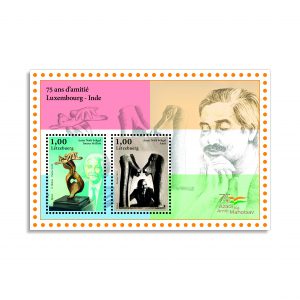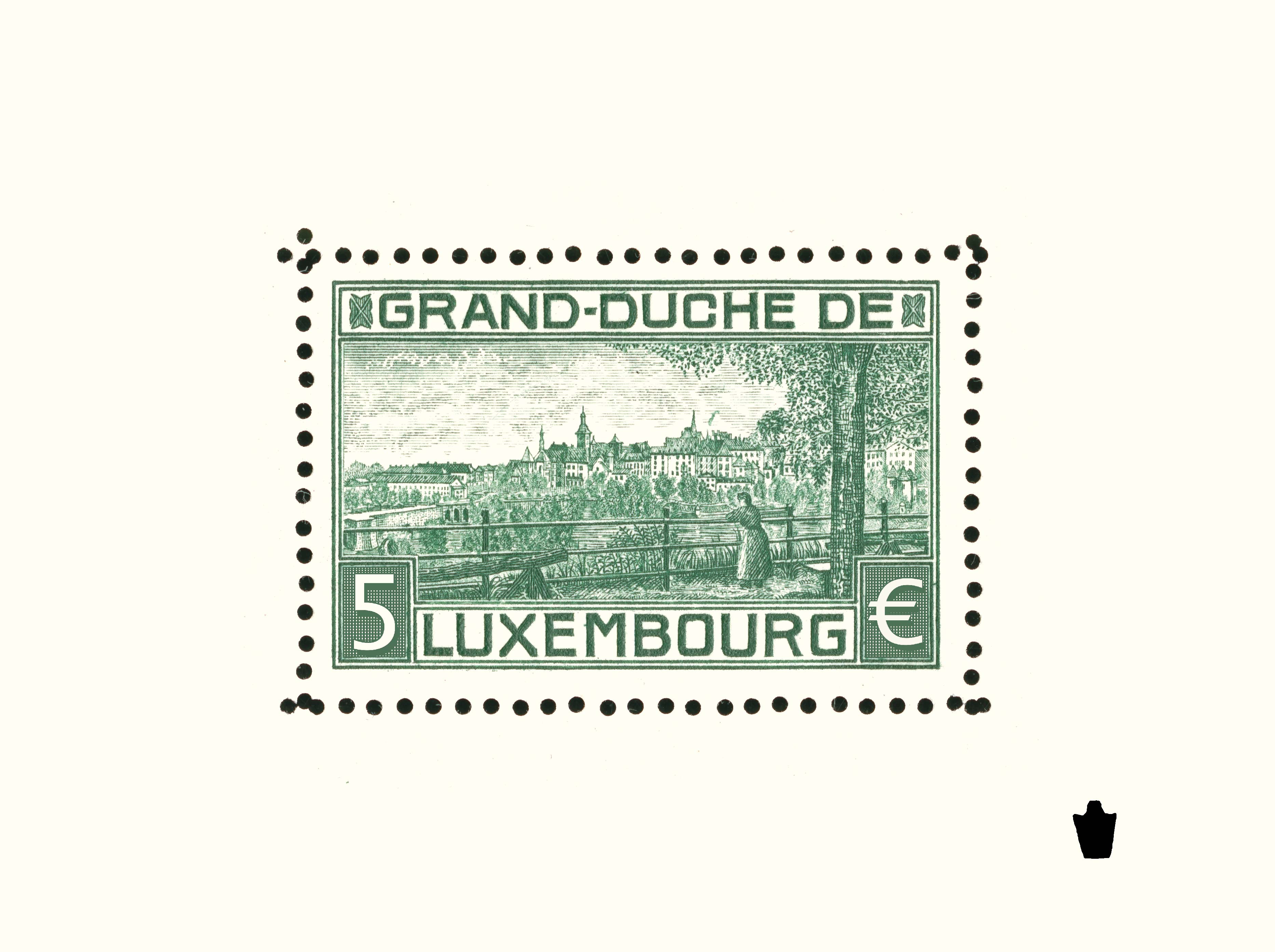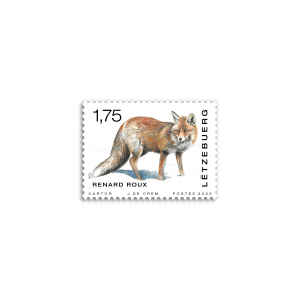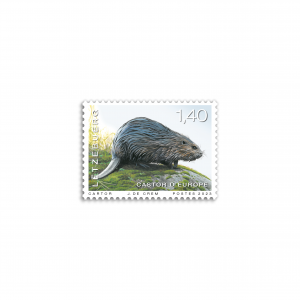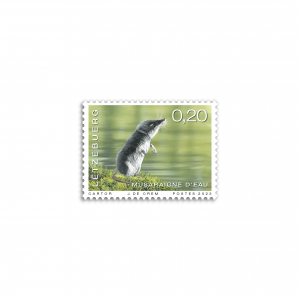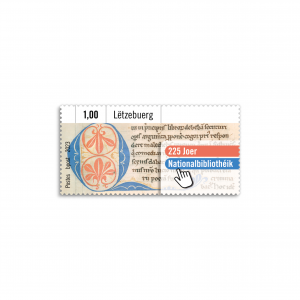POST Luxembourg is issuing a new series of stamps on March 14th 2023.
The friendship between Luxembourg and India will be honored. In 2023, the Grand Duchy and India celebrate 75 years of their diplomatic relations.
Two sculptures by Indian sculptor Amar Nath Sehgal were chosen as motifs for the joint souvenir sheet.
Furthermore , a copy of the world’s first stamp block, issued in Luxembourg in 1923, will be released. The original stamp has been exactly reproduced. Only the tariff and the currency have been replaced.
In cooperation with the “Administration de la nature et des forêts », a special series will show drawings of “Mammals in Luxembourg” made by Johan de Crem, a well known animal painter.
Last but not least, a special stamp commemorating the 225 years of the National Library of Luxembourg will be issued.
Block
75-year friendship between Luxembourg and India Joint issue with India
In 2023, the Grand Duchy of Luxembourg and the Republic of India celebrate the 75th anniversary of the start of their diplomatic relations on 1 July 1948.
As a result of cooperation in the steel sector, the first vice consulate was opened in Bombay in 1929. The opening of the Luxembourg Embassy in New Delhi in February 2002 has allowed to develop an amicable relationship between the two countries, both of which are particularly committed to democratic values. They have stepped up and diversified their cooperation in the areas of politics – both countries being ardent supporters of multilateralism – as well as trade, finance and culture. A series of visits and good high-level exchanges helped to deepen the relationship over the years, with Luxembourg companies setting up in India and vice versa. In 2022, Luxembourg was India’s 15th largest foreign direct investor overall. Interpersonal connections have also grown, and the number of Indians in Luxembourg now stands at close to 4,000 people.
Amar Nath Sehgal
Two sculptures by the Indian sculptor,painter and poet were chosen as motifs fort the joint souvenir sheet. He set up a studio in Luxembourg in the late 1970s and lived and worked in both Luxembourg and India until the early 2000s. Amar Nath Segal was born in Northern Punjab – now part of Pakistan – on 5 February 1922. He initially studied engineering in India, although art was already very important to him at that time. The rest of his life was shaped and influenced by the unrest caused by religious and ethnic conflict before the partition of India in 1947, resulting in the creation of two independent states: Pakistan and India. Having witnessed these civil warlike conflicts, art gave him the opportunity to express political and social messages.
In the late 1940s, Sehgal’s studies of art and art education took him to the USA. On his return to India after graduating in 1950, in addition to his own artistic pursuits, he taught at institutions such as the College of Art in New Delhi. His first exhibition ever was held in New York in 1951. In 1966, he had his first exhibition in Luxembourg at the National Museum of History and Art (Musée national d’histoire et d’art). One of Amar Nath Sehgal’s well-known works is his bronze bust of Mahatma Gandhi, commissioned by a Luxembourg philanthropist, which was installed in the city’s municipal park in 1973. However, the original was stolen in 1980. Sehgal donated an original copy of this bust in 1982 on the 113th birthday of Mahatma Gandhi.
Amar Nath Sehgal died in New Delhi on 28 December 2007
Block
100 years of the world‘s first stamp block
On 3 January 1923, the Luxembourg post office became the first postal service in the world to issue a souvenir sheet, on which, in this case, was only one stamp. The reason for this was that only a single cliché was available for production, and therefore it was not possible to produce a sheet with several stamps.
As the block was issued to commemorate the birth of Princess Elisabeth, the second child of HRH Grand Duchess Charlotte, in December 1922, and the postal administration did not want to wait to produce more clichés, they decided to issue the sheet with a single stamp.
A total of 5,100 sheets were issued, with a value of 10 francs – a lot of money at the time. The souvenir sheet was produced by Enschedé in Haarlem (NL) using the gravure printing process. Correspondence with the printer shows that the first delivery of the souvenir sheet was on 28 December 1922.
The motif shows a view of the City of Luxembourg and is coloured in green. The souvenir sheet is therefore also referred to as the “Grénge Block”. It measures around 80 x 59 mm.
The engraving was by Henry-Lucien Cheffer, a French artist from Paris. The original motif of the view was first used in August 1921 on a stamp whose surtax was utilized in aid of the erection of the monument to the victims of the First World War, the “Gëlle Fra”.
The current anniversary souvenir sheet is based – as far as it is possible today – on the appearance of the original souvenir sheet. It is coloured in green and the same motif as in 1923 is used. Even in the perforation technique and the choice of paper, it closely resembles its model, including an imitation of the crown perforation, which at the time was a sign of quality control before delivery to the Luxembourg postal administration. Unlike today, 100 years ago, the perforation, also called line perforation, was made individually and by hand.
Special series
Mammals in Luxembourg
In the third part of the special series, produced in cooperation with the Administration de la nature et des forêts in Luxembourg, the motifs depict a rodent (the beaver), a predator (the fox), a bat (the grey long-eared bat) and an insectivore (the water shrew).
This selection once again shows mammals from different orders, highlighting the unusual and unique aspects of each animal, as well as the diversity of mammals.
Water shrew / Neomis fodiens
The habitat of the water shrew, the largest shrew in Europe, is in clean, mostly fast flowing waters with small, low-flow sections with good bank structures adjacent to forests. Populations are threatened by human encroachment on these habitats. Water shrews feed mainly on spiders, snails, earthworms and small crustaceans, but also on frogs, newts and fish, which they kill with their venom. Although it mainly stays near the water, the water shrew roams – chiefly at dusk – in an area of 100 to 400 m2 around its burrow, which it digs itself in the bank vegetation or takes over from other semiaquatic mammals.
Grey long-eared bat / Plecotus austriacus
The grey long-eared bat, which only grows to up to 6 cm in size, can have a wingspan of 29 cm and is particularly recognizable by its long ears. Its nursery roosts consist of clusters of up to 30 females in the roof spaces of churches and other buildings, which means that providing access to these spaces is very important for the protection of this species. The grey long eared bat feeds on insects, with moths accounting for 70-100%. It hunts for them up to 7 km from its habitat in domestic gardens, around street lights, in orchards, meadows, pastures and scrubland. This very cold-resistant species hibernates in man-made structures or in underground quarters.
European beaver / Castor fiber
Hunted to extinction in Luxembourg in the 19th century, the European beaver has returned to the country thanks to its active reintroduction in Belgium since 2008. The semiaquatic nocturnal and semi-nocturnal beaver lives partly along large rivers or small streams, where it builds dams if necessary. One of its particularly distinctive features is its typical horizontally flattened scaly tail. European beavers live in family groups of two to eight animals. They are strictly herbivorous, feeding on leaves and water plants, and in winter also on tree bark.
Red fox / Vulpes vulpes
As an omnivore, the red fox is found in forests, meadows and agricultural land, where it eats mainly mice, rats, insects, amphibians and worms. Carrion is also one of its food sources, and thus removing a potential source of disease foci. In the autumn, it also looks for fatty plants, especially fallen fruit. Fox dens – located in hedgerows, embankments and at the edge of forests – are used primarily for rearing cubs. The red fox is very adaptable, which means that it has been found in villages and towns for decades. In Luxembourg, the red fox has acquired special national significance thanks to Michel Rodange’s epic work “De Renert”.
Special stamp
225 years of the National Library of Luxembourg
Luxembourg’s first public library was founded in 1798, when the Duchy was part of the French Republic as the Département des Forêts. Almost 100 years later, in 1899, the library was mentioned for the first time in a document as the national library (Bibliothèque nationale). It was given a legal basis by the law of 5 December 1958.
The historically valuable old books held by today’s National Library come from various libraries, including the monastic libraries in Echternach, Orval and Münster in the City of Luxembourg. The oldest individual book dates back to the seventh century.
Today, the National Library is the country’s largest scientific and public library. All works published in Luxembourg in digital or analogue form, as well as all works published in other countries that have a connection to Luxembourg, are collected, catalogued and stored here. Its collection comprises 1.8 million printed documents, around three quarters of which are not from Luxembourg, as well as a growing number of e-books, databases and digital publications. A wide variety of subjects are covered, from anthropology to zoology. Access to the facilities is open to anyone interested. To ensure the sharing of knowledge, the staff at the National Library organise themed exhibitions, conferences, and lectures, as well as design and produce their own publications.
The National Library acts as coordinator of the national network of Luxembourg libraries and cooperates with foreign libraries and library associations.
On 1 October 2019, the National Library moved from the former Athenaeum building in the city centre to its new premises in Luxembourg-Kirchberg, which provides everything a modern library needs.

 Åland
Åland  Faroe Islands
Faroe Islands  Gibraltar
Gibraltar  Greenland
Greenland  Guernsey
Guernsey  Isle of Man
Isle of Man  Jersey
Jersey  Liechtenstein
Liechtenstein  Luxembourg
Luxembourg  Malta
Malta  Monaco
Monaco  Vatican City
Vatican City 